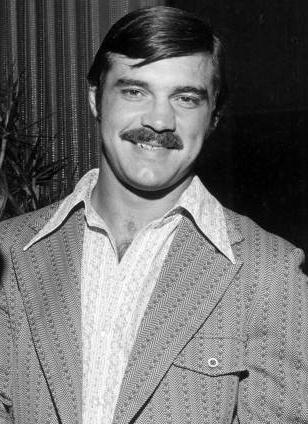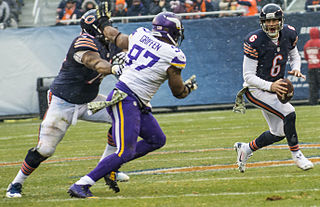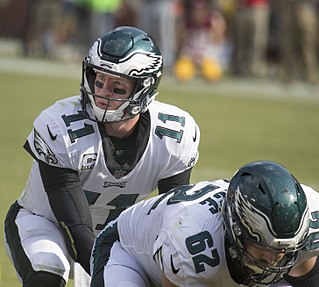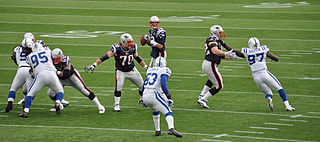
Larry Richard Csonka is an American former professional football fullback in the National Football League (NFL) for the Miami Dolphins for the majority of his career, along with the New York Giants for three years. He also had a short stint with the Memphis Southmen in the WFL. Nicknamed "Zonk", Csonka is widely regarded as one of the greatest running backs of all time. Csonka is mostly remembered for his success during his tenure with the Dolphins, which included being a member of their 17–0 perfect season in 1972, and winning Super Bowl championships in 1972 and 1973, the latter of which he was named Super Bowl MVP when he ran for a then-record 145 yards. He was also a commentator for the original run of American Gladiators.

In gridiron football, a lineman is a player who specializes in play at the line of scrimmage. The linemen of the team currently in possession of the ball are the offensive line, while linemen on the opposing team are the defensive line. A number of NFL rules specifically address restrictions and requirements for the offensive line, whose job is to help protect the quarterback from getting sacked for a loss, or worse, fumbling. The defensive line is covered by the same rules that apply to all defensive players. Linemen are usually the largest players on the field in both height and weight, since their positions usually require less running and more strength than skill positions.

A cornerback (CB) is a member of the defensive backfield or secondary in gridiron football. Cornerbacks cover receivers most of the time, but also blitz and defend against such offensive running plays as sweeps and reverses. They create turnovers through hard tackles, interceptions, and deflecting forward passes.
In gridiron football, blitzing is a tactic used by the defense to disrupt pass attempts by the offense. During a blitz, a higher than usual number of defensive players will rush the opposing quarterback, in an attempt either to tackle them or force them to hurry their pass attempt.

Defensive end (DE) is a defensive position in the sport of gridiron football.
Strategy plays a crucial role in American football. Both teams carefully plan various aspects of their gameplay in an effort to win. This includes deciding on formations, selecting players for specific positions, and assigning roles and instructions to each player on offense and defense.

The 46 defense is an American football defensive formation, an eight men in the box defense, with six players along the line of scrimmage. There are two players at linebacker depth playing linebacker technique, and then three defensive backs. The 46 defense was originally developed and popularized with the Chicago Bears by their defensive coordinator Buddy Ryan, who later became head coach of the Philadelphia Eagles and Arizona Cardinals.
A formation in American football refers to the position players line up in before the start of a down. There are both offensive and defensive formations and there are many formations in both categories. Sometimes, formations are referred to as packages.

Center or centre (C) is a position in American football. The center is the innermost lineman of the offensive line on a football team's offense who passes the ball between his legs to the quarterback at the start of each play.

The passing pocket, or the pocket, is a term used in American football to describe the area in the backfield created on a passing play where the offensive line forms a wall of protection around the quarterback. This allows him adequate time to find an open receiver and to pass the ball. The offensive line will drop back slightly, creating a U-shaped protected area for the quarterback to find an open receiver and pass the ball.

A halfback (HB) is an offensive position in American football, whose duties involve lining up in the offensive backfield and carrying the ball on most rushing plays, i.e. a running back. When the principal ball carrier lines up deep in the backfield, and especially when that player is placed behind another player (usually a blocking back), as in the I formation, that player is instead referred to as a tailback (TB).

In American football, the specific role that a player takes on the field is referred to as their "position". Under the modern rules of American football, both teams are allowed 11 players on the field at one time and have "unlimited free substitutions", meaning that they may change any number of players during any "dead ball" situation. This has resulted in the development of three task-specific "platoons" of players within any single team: the offense, the defense, and "special teams". Within these three separate "platoons", various positions exist depending on the jobs that the players are doing.

The triple option is an American football play used to offer six ways to move the football forward on the field of play. The triple option is based on the option run, but uses three players who might run with the ball instead of the two used in a standard option run.
In American football, a play is a close-to-the-ground plan of action or strategy used to move the ball down the field. A play begins at either the snap from the center or at kickoff. Most commonly, plays occur at the snap during a down. These plays range from basic to very intricate. Football players keep a record of these plays in a playbook.

In American football, the 3–4 defense is a common defensive alignment consisting of three down linemen and four linebackers. It is called a "base defense" because it will readily switch to other defensive alignments as circumstances change. Alternatively, some defenses use a 4–3 defense: four down linemen and three linebackers.

In American football, a 4–3 defense is a defensive alignment consisting of four down linemen and three linebackers. It is called a "base defense" because it is the default defensive alignment used on "base downs". However, defenses will readily switch to other defensive alignments as circumstances change. Alternatively, some teams use a 3–4 defense.
The following terms are used in American football, both conventional and indoor. Some of these terms are also in use in Canadian football; for a list of terms unique to that code, see Glossary of Canadian football.

The 7–1–2–1, or seven-diamond defense, used seven "down linemen", or players on the line of scrimmage at the time of the snap, one linebacker, two safeties relatively close to the line and one safety farther downfield. The formation was created by Minnesota Golden Gophers coach Henry L. Williams in 1903, reputedly to stop Michigan back Willie Heston. By some accounts in the mid-1930s, the 7–1–2–1 was considered "almost obsolete" due to its weakness against the forward pass, whereas the 7–2–2 defense was still considered viable. Yet Bill Arnsparger notes the use of the seven-diamond from the 1940s into the 1960s, as a defensive adjustment to the common wide tackle 6 defenses of the time. Further, the form of the 7 diamond as derived from a wide tackle 6, with a more compact line spacing than the 1930s era 7 man lines, shows a marked similarity to the 46 defense of Buddy Ryan.
In American football, the 6–2 defense is a defensive alignment consisting of six down linemen and two linebackers.














